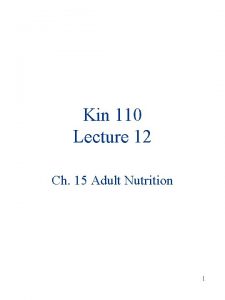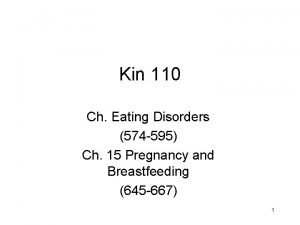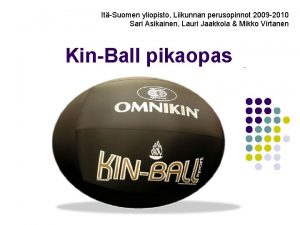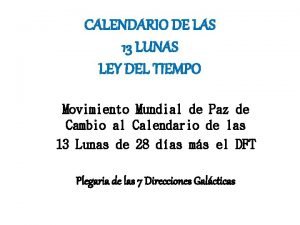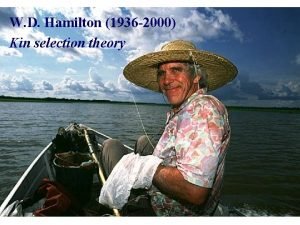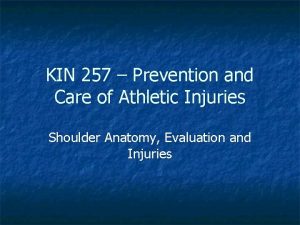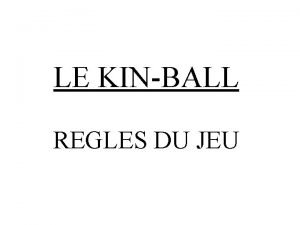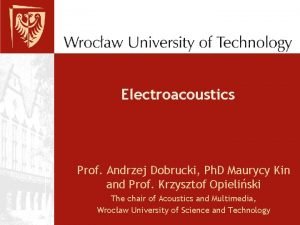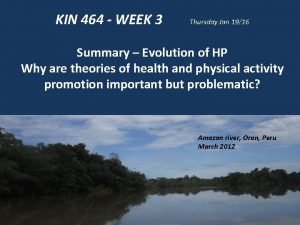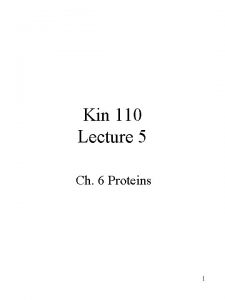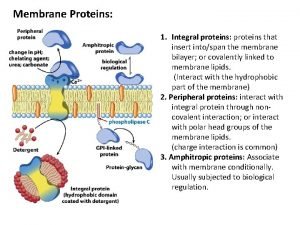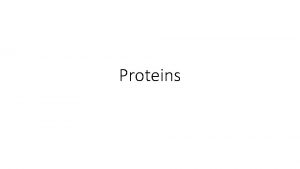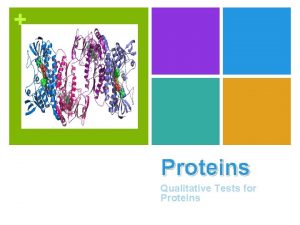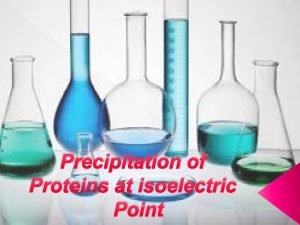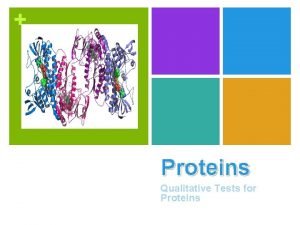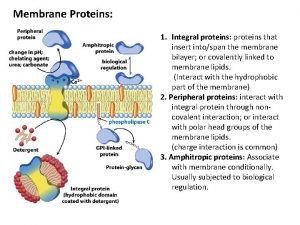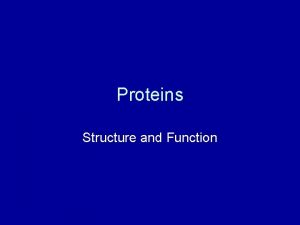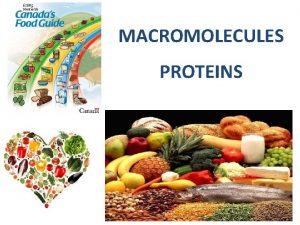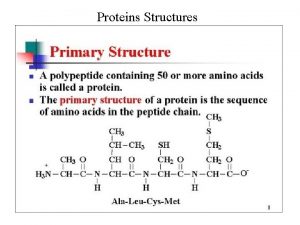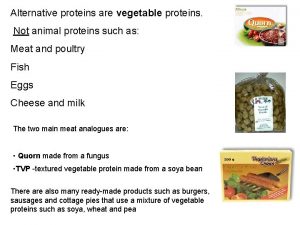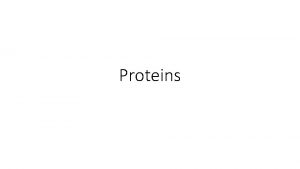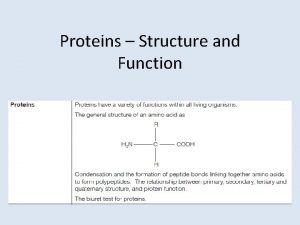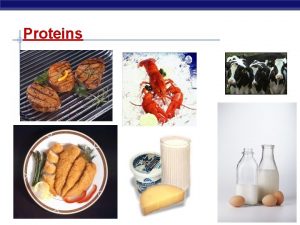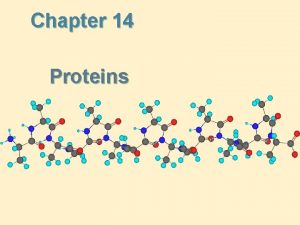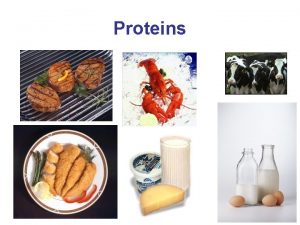Kin 110 Lecture 5 Ch 6 Proteins 1


















- Slides: 18

Kin 110 Lecture 5 Ch. 6 Proteins 1

Overview of Proteins • Thousands of substances in body are make of protein • Major non-water component of lean tissue (16 %) • 20 different amino acids – building blocks of protein – 9 essential - must be obtained from diet • Complete protein – high quality - all essential a. a. • Incomplete protein – lower quality - lack sufficient amount of one or more essential a. a. – simple combinations - complementary 2

Overview of Protein • Proteins crucial for thousands of body processes • each function requires specific protein • sequence of a. a. determines structure and function • body uses a. a. form diet as building blocks for many configurations and sizes of proteins for these varied functions • without proper essential a. a. in diet, body functions slow, immune system begins to fail 3

Amino Acids • Amino acids have general structure • variations in ‘R’ region determine functional characteristics (p. 176) • 20 a. a. - 9 essential - can not be made by the body • Table 6 -1, p 177 • Physiologically essential – PKU - Phenylketonuria – inability to process phenylalanine (ess. ) into tyrosine (non-ess. ) – Tyrosine becomes an ess. a. a. 4

Dietary Considerations (ess. vs. non-ess. ) • Complete protein – contains all 9 ess a. a. – Animal and Soy protein • Incomplete protein – lacks one or more ess a. a. – most plant proteins • Important as all a. a. are necessary for protein synthesis • All or None Principle of protein synthesis – ALABAMA eg. 5

Complementary Proteins • Various plant sources can compensate for ess a. a. deficiencies • Adults should have little concern, combination over entire day is important • more attention required for young children • Fig. 6 -2, p 179 • * know traditional combinations that make complete protein in diet * 6

Protein • Amino acids joined by peptide bonds – thousands of different proteins – Letters making sentences, paragraphs • order directed by DNA, genes • Creates specific and unique 3 -D structure, necessary for functioning • Eg. Sickle cell anemia 7

Denaturing of Protein • • Acid, alkaline, Heat or agitation alters protein 3 -D structure destroys normal function Cooking, makes foods safer to eat and facilitates further digestion (exposure to enzymes) • * recall - we dismantle proteins for the a. a. building blocks* 8

Digestion and Absorption • Begins in stomach – Enzyme Pepsin – breaks proteins into smaller a. a. sequences (selected bonds) • Creates Peptones • Hormone Gastrin controls release of Pepsin and Acid – acid activates pepsin and denatures proteins 9

S. I. And Protein • Protein and Fat in SI trigger pancreatic juice to be released • Divides peptones into smaller sequences • Broken into a. a. and short sequences for absorption • travel to liver (portal circulation) – recombined into protein – converted to glucose or fat – released to blood 10

Functions of Proteins • To ensure availability of ingested protein for these functions, you must take in sufficient carbohydrates and fat for energy needs • Vital body constituents – most are in a constant state of breakdown , rebuilding and repair – most a. a. can be recycled, by some are lost, requiring constant intake in small amounts. 11

Other Protein Functions • Fluid balance – Blood Proteins – albumin and globulins bring fluid back into the bloodstream after in leaves at the capillaries • prevent edema (swelling) • Acid Base Balance – proteins in membranes pump ions in an out – buffers; take away and add acid (H+) as required 12

Other Protein Functions • Hormones, Enzymes and Neurotransmitters • Immune Functions • Antibodies • Rapid production requires ample protein availability • excess protein does not boost immune function • Formation of glucose and Fat • Provision of Energy – costly processing 13

Protein Intake • Protein equilibrium • need to balance intake with output • output measure as nitrogen in urine (protein broken down) • fig 6 -6 p 189 • Positive balance - required for growth, recovery from illness, training – requires insulin, growth hormone, testosterone • Negative balance - occurs with inadequate intake, infections, bed rest 14

RNI for Protein • • . 8 g/Kg healthy body weight double for infants 56 g for 155 lb man 44 g for 120 lb woman 2 -3 servings per day Table 6 -3 p 191 mental stress and physical labor do not increase requirement • World class athletes may benefit from up to 1. 5 g /Kg • Pregnancy inc. need by 10 -15 g • elderly may have higher needs 15

High Protein Diet? • Increased saturated fat intake, lower fiber intake • May increase loss of calcium • may relate to colon cancer • may accentuate heart disease – homocysteine • Recommended not to exceed 2 X RNI • whole foods NOT supplements • average diet already 1. 5 -2 X RNI • athlete diet already larger, take in more protein with balanced diet 16

Protein Source • • • Animal - most dense source 65 % animal protein in US 20 % in Africa, parts of Asia Plant sources - complementary high in Magnesium and Fiber no cholesterol and little saturated fat 17

Vegetarianism • Why ? • Political, Ecological, Health reasons • soy protein – lowers LDL – antioxidant – vascular dilation • Vegan - only plant foods • Lacto-vegetarian - plant and dairy • Lacto-ovo vegetarian - plants, dairy and eggs • Omnivore - both plant and animal • Concerns - essential a. a. , essential fatty acids, vitamin B-12, calcium 18
 Kin 110
Kin 110 Kin 110
Kin 110 Vignette mutuelle 110/110
Vignette mutuelle 110/110 000 111 000
000 111 000 01:640:244 lecture notes - lecture 15: plat, idah, farad
01:640:244 lecture notes - lecture 15: plat, idah, farad Liikunnan perusopinnot
Liikunnan perusopinnot Valum votan
Valum votan I sut
I sut Tsui ka kin
Tsui ka kin William hamilton kin selection
William hamilton kin selection Kin 240
Kin 240 Hamilton's rule kin selection
Hamilton's rule kin selection Kin 257
Kin 257 Linh kin
Linh kin Kin-ball règles
Kin-ball règles Pinna acoustics
Pinna acoustics Kin tes
Kin tes Life orientation grade 7 term 2 exam papers
Life orientation grade 7 term 2 exam papers Kin 464
Kin 464
